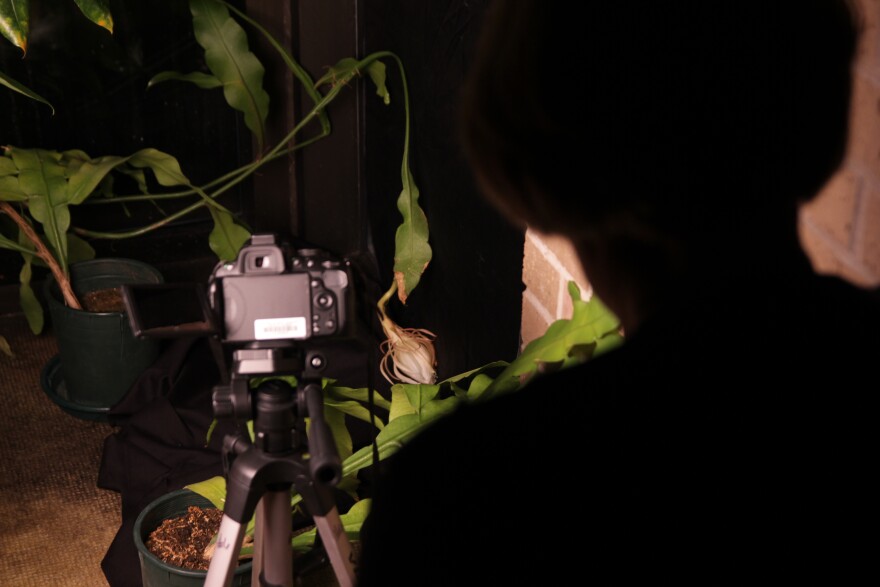At around 9:00 on a late spring evening, the library was locked for the night. Silently, Linda Zellmer appeared on the other side of the glass door. She opened it and guided us up four dark floors towards a puddle of light.
"There it is," she said, gazing down at the swollen bud of an orchid cactus. "It’s slowly opening."
Zellmer, a librarian at the Leslie F. Malpass Library at Western Illinois University, perched on a stool behind her camera and waited in anticipation of the night’s big event: the moment when thebud opens.
While most plants flower for weeks, orchid cacti blossom only for a few short hours a year, and always at night. Botanists call it Epiphyllum oxypetalum, but the plant’s elaborate, nocturnal mating dance has earned it the nickname of “Queen of the Night” or “Lady of the Night.”
The orchid cactus flowers in hopes of reproducing. Its strong, sweet smell is meant to draw pollinators, such as birds and bugs.
“When it opens up, you can smell it. Like, this whole area will smell like this flower,” Zellmer said, snapping photos.
“Sometimes it gets to the point where it’s really overpowering.”
This particular Lady of the Night lives a solitary life, rooted in a small pot under the shadow of an umbrella tree. But tonight is its one chance to do what it was meant to do: spread its seeds.
“It is a very, very showy flower,” Zelmer said.
But it’s also particular.
“Things have to be totally right to bloom,” she said.
Zellmer spends her days reading academic journals and deciphering maps. When she takes a break, she likes to leave her cluttered office and sit in the building’s common area, amidst the thousands of potted plants the library houses.
“The plants provide a different kind of atmosphere,” she said. “They clear the air.”

Malpass Library opened in 1976 and was arguably designed more for plants than for books and people. Made mostly of glass, the library is humid and prone to molding. Its six stories are built around a central atrium crowned by a 15 foot tall fig tree.
Every nook and cranny is filled up, forcing patrons to duck under hanging pots of ferns and squeeze in between bookshelves and the century old jade plant.
The orchid cacti first caught Zellmer’s eye last August when one of the library’s three specimens threw off several buds. As students and faculty celebrated outside during the university’s welcome back party, Zellmer sat alone in the library, watching.
“It looks like a little spider in the middle. But it’s this pure white.” Her eyes light up with the memory. “And it smells wonderful.”
The scientific community recognizes a man named A. P. de Candolle for first discovering the plant in 1828. In the nearly two centuries since, its beauty has been mythologizedby epic poets and its essence bottled.
Some cultures claim orchid cactus stem extract works as a cough suppressant, while others cook the petals into a soup that’s assumed to be an aphrodisiac. In Southeast Asia, it’s revered as a sacred hometo the Hindu god Brahma and it’s believed if you pray while it’s blooming, your prayers will be answered.
In the U.S., the plant is popular among gardeners (scroll halfway down the page) who invite friends over for bloom night, pour wine, and watch.
In early May, Zellmer noticed it happening again. The orchid cactus on the fourth floor began pushing out a single green bud that hung down from its fleshy stem.
She photographed as it extended four inches long. Then, she said, it stood up - eager for birds and bugs to swoop in and collect some of its pollen.
“The stem that the flower is on literally hooks up. Hooks like a shepherd's hook,” she said. “And right now, the flower is so heavy that it’s just lying on the floor.”
In its native habitat, stretching from the sub tropics of Mexico to the rainforests of South America, the orchid cactus would never touch the ground. Instead, it clings to the branch of a tree 40 to 60 feet up where it can grow 20 feet tall, wrapping its roots around the tree’s trunk and feeding on sunlight, rain, and air.
Perched in the rainforest canopy, the flower blooms bathed in moonlight amidst the whirl and buzz of nigh-time creature life.
The library is silent.

At 10:00 p.m. it started to happen. First, the bud’s outermost petals peeled back, wiry and pink. Then, the middle layers fringed and parted, long and thin like a piano player’s hand.
Next, the flower’s central blossom ballooned and its wide, opal petals started to unravel. By full bloom, they stretched to the size of a dinner plate, revealing a beaming white, almost iridescent, center.
At this point, the blossom literally threw off heat; its warmth is a Siren's call to the forest’s hummingbirds, bats, and moths.
If the orchid is lucky, one of these nighttime flying creatures will be covered in pollen from another orchid cactus. As the creature dips into the base of the petals for a sip of nectar, the pollen will brush off on the flower’s frilly stigma and trickle down a long tube, called the pistol, into the flower’s center, fertilizing the tapioca-like embryos inside. Then, the plant can bear forth a big red fruit, filled with orchid cactus seeds.
But that never happens for the orchid cacti in Malpass Library, which attract people, not pollinators.
“Ours have never produced fruit because they never get pollinated,” Zellmer said.
A little before midnight, Zellmer packed up and headed off. By the time she returned for work the next morning, the blossom was spent and the cactus looked like just another plant in the library.
That is, until next year.






